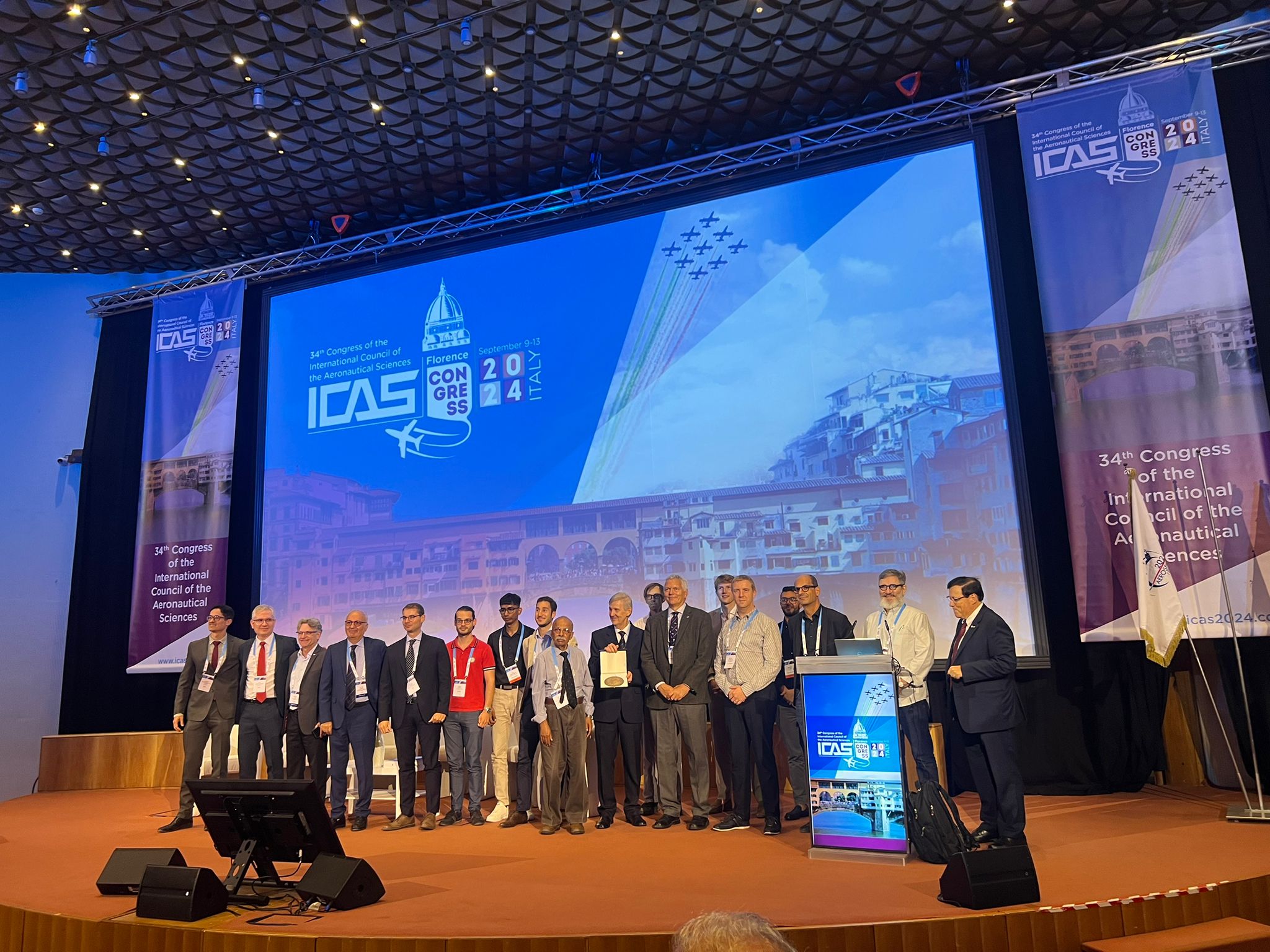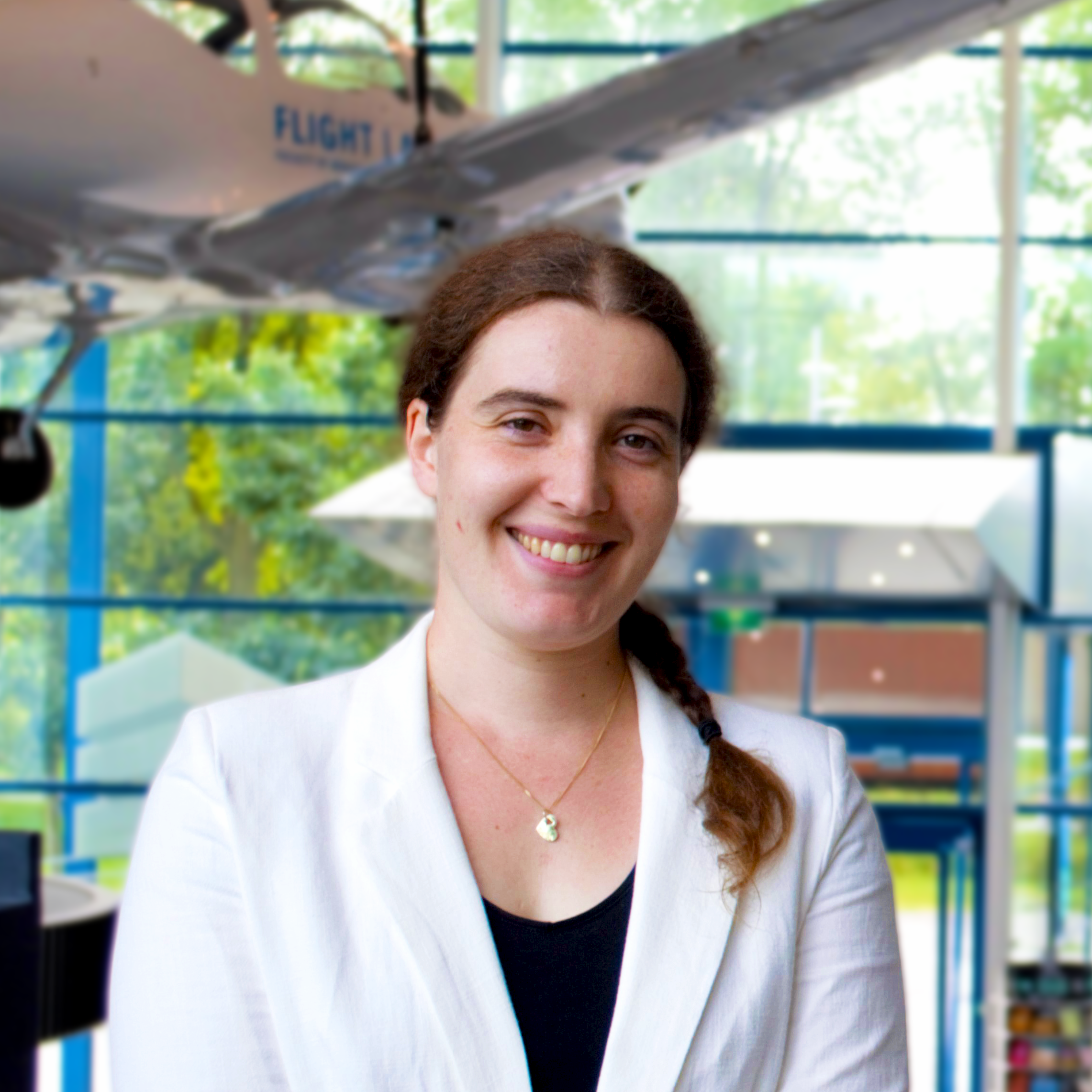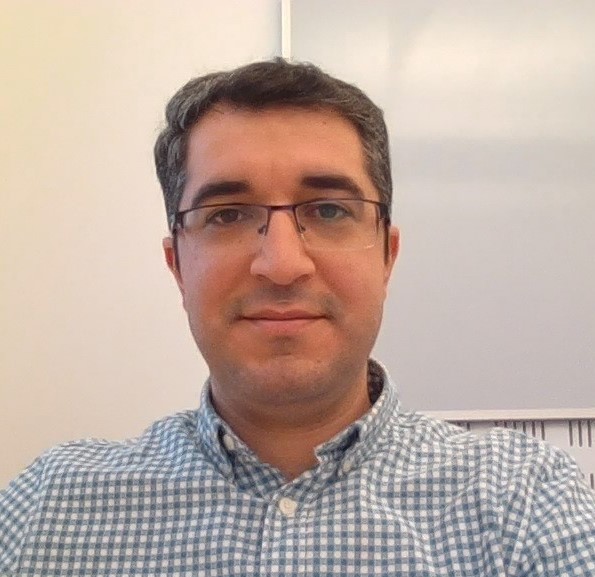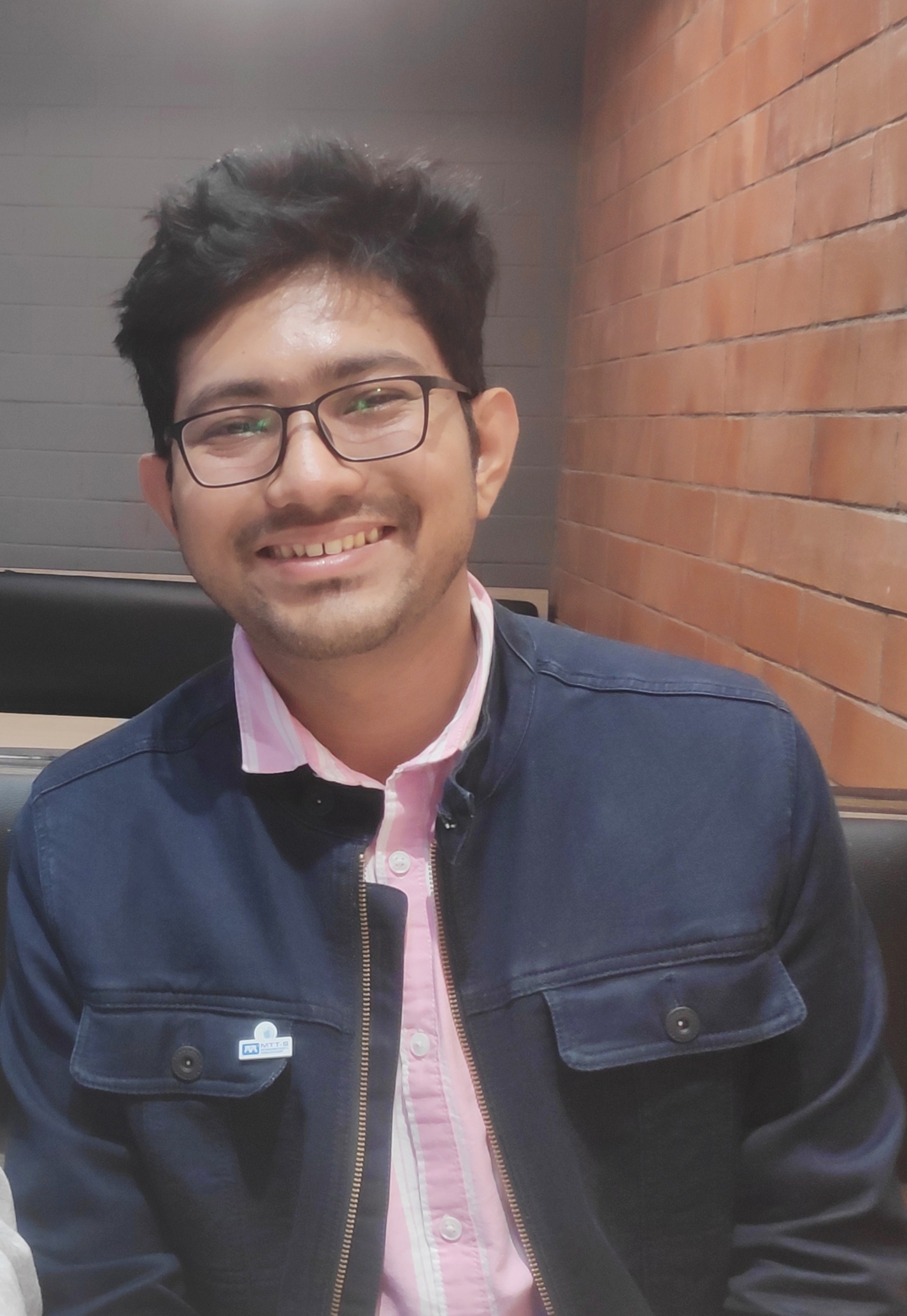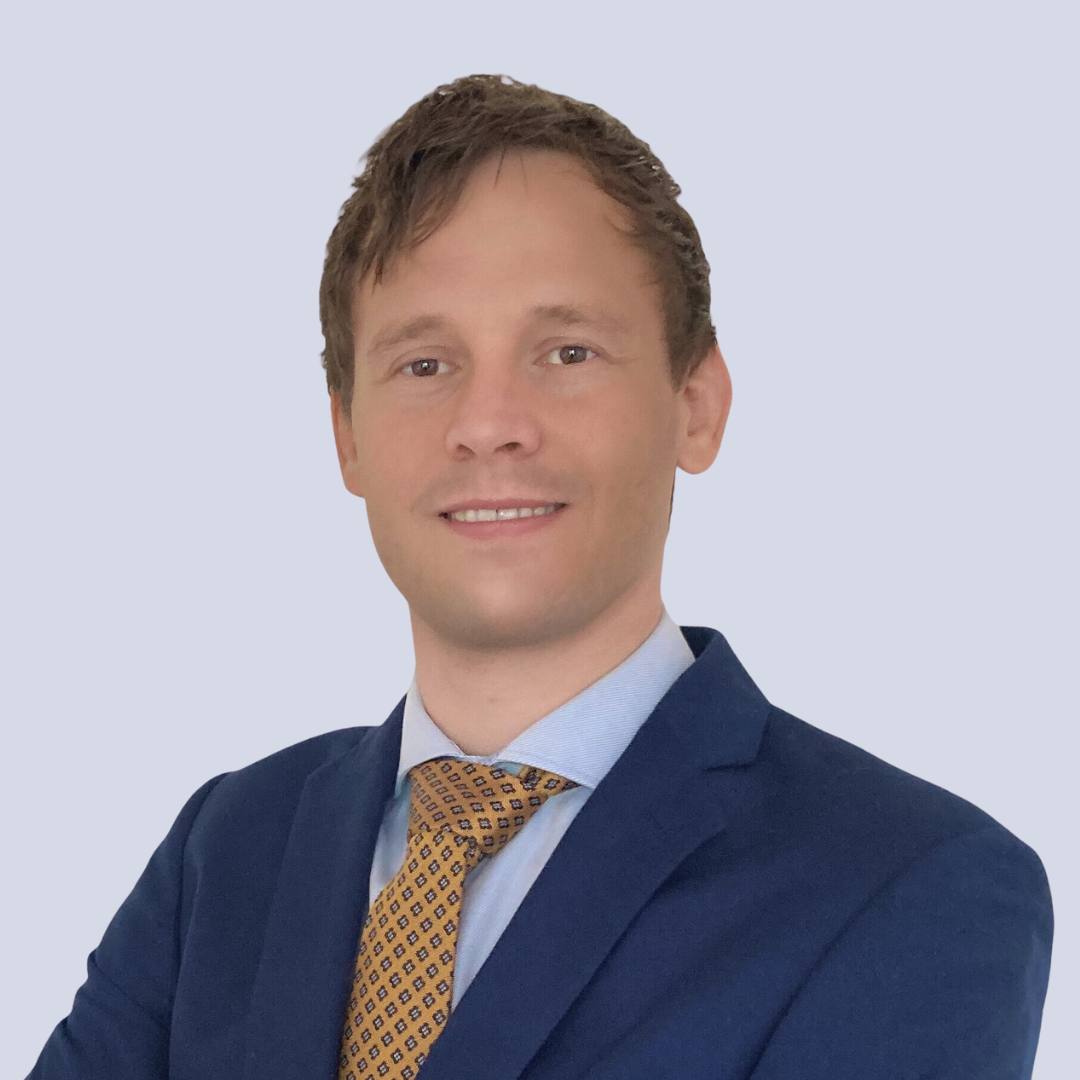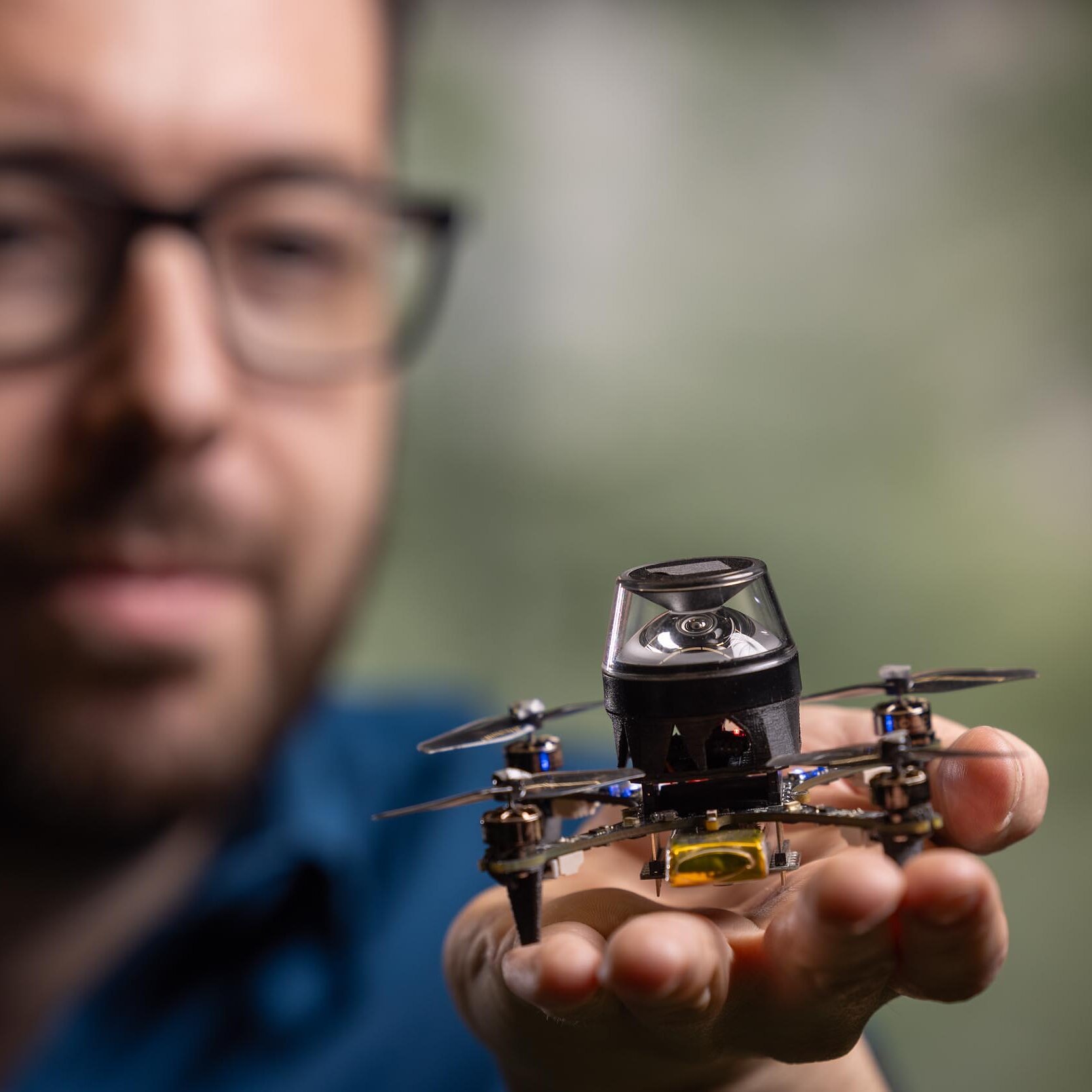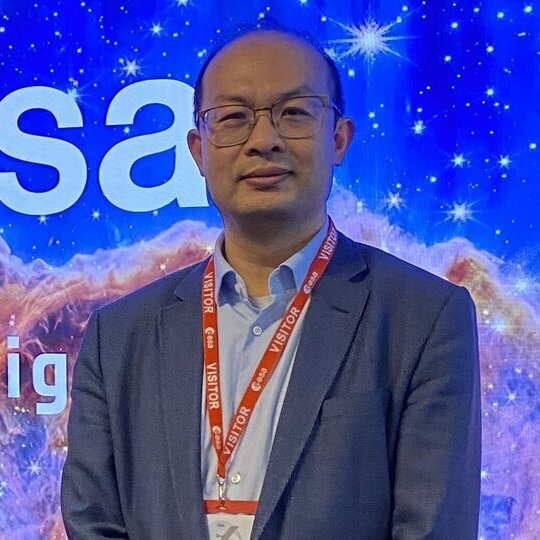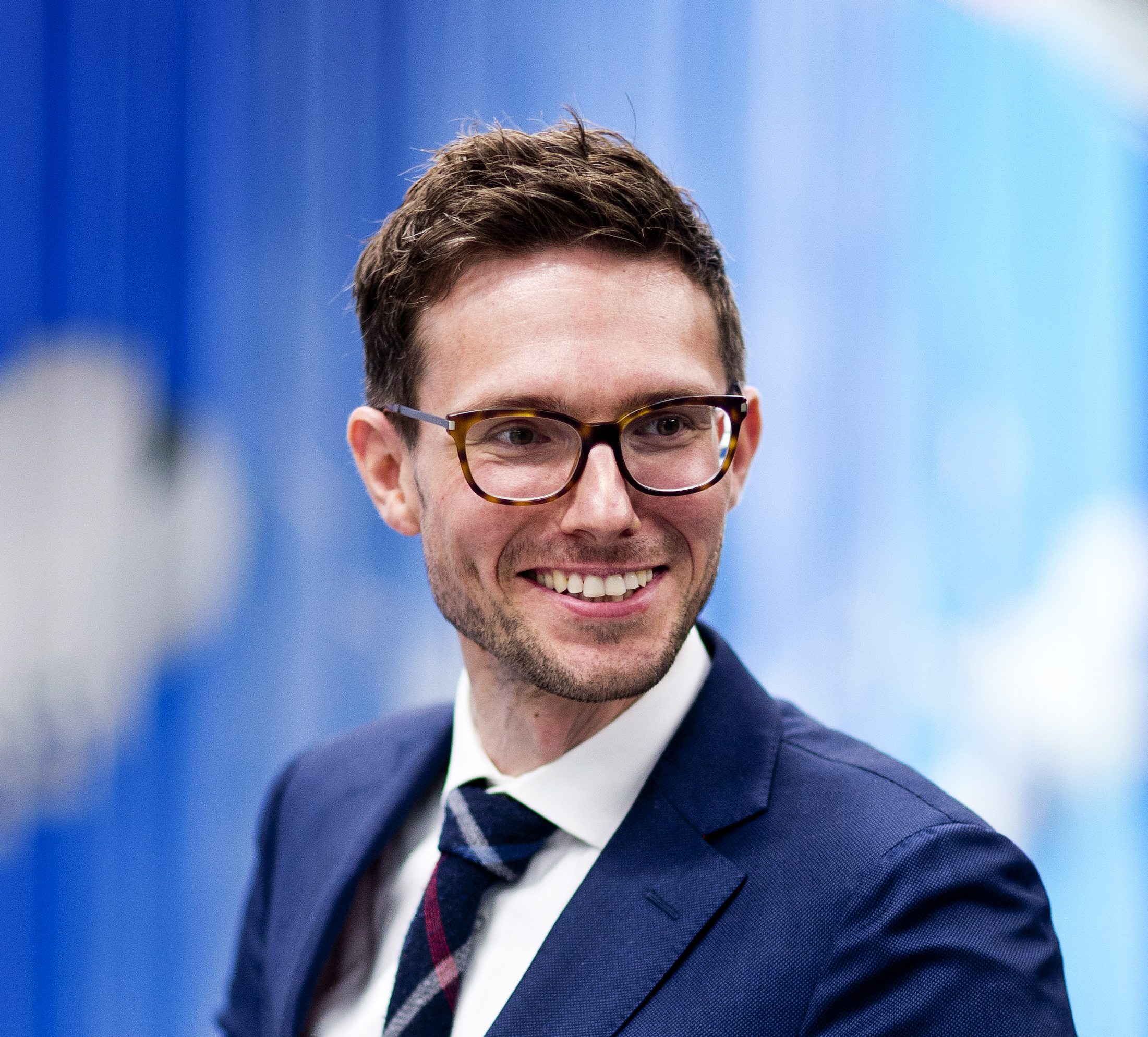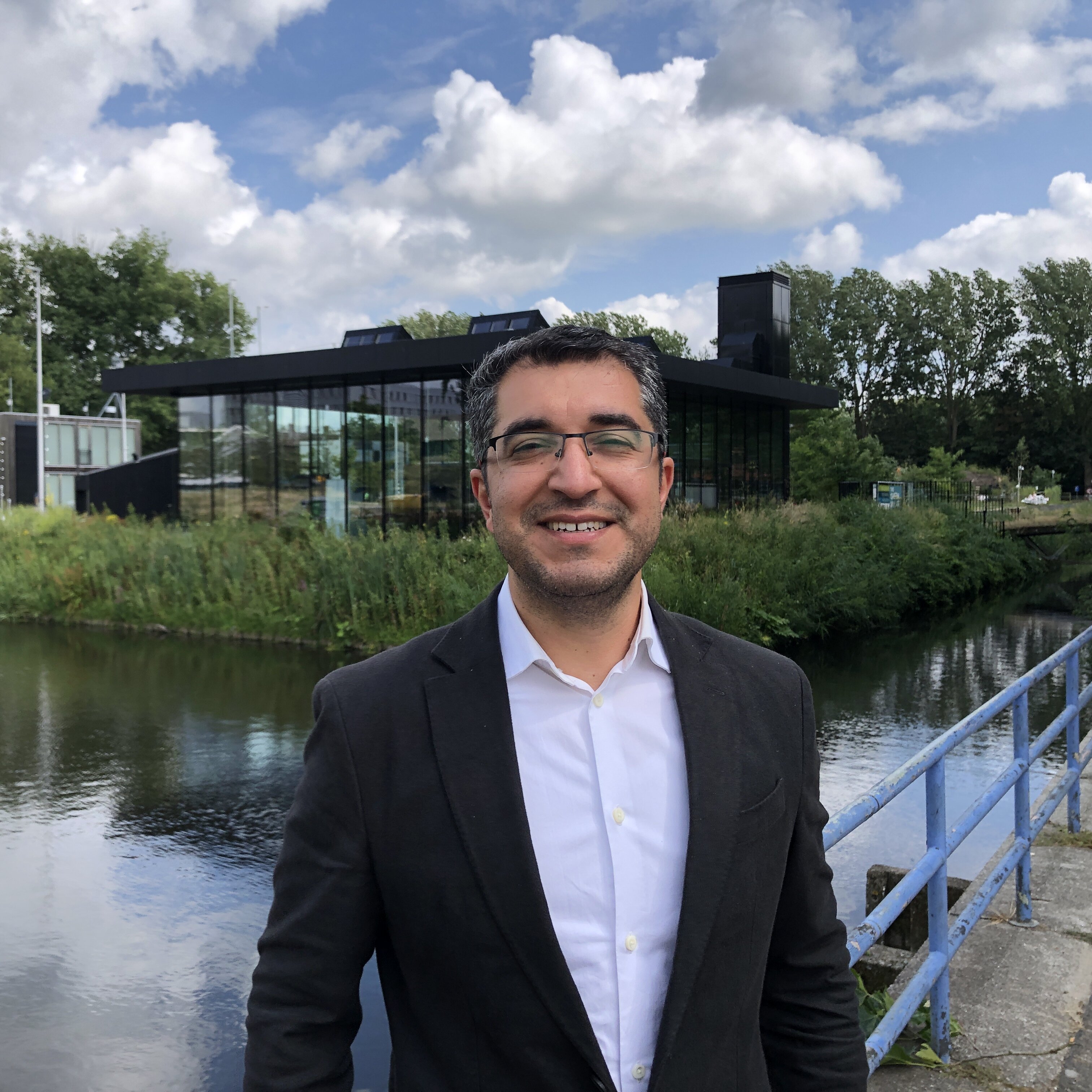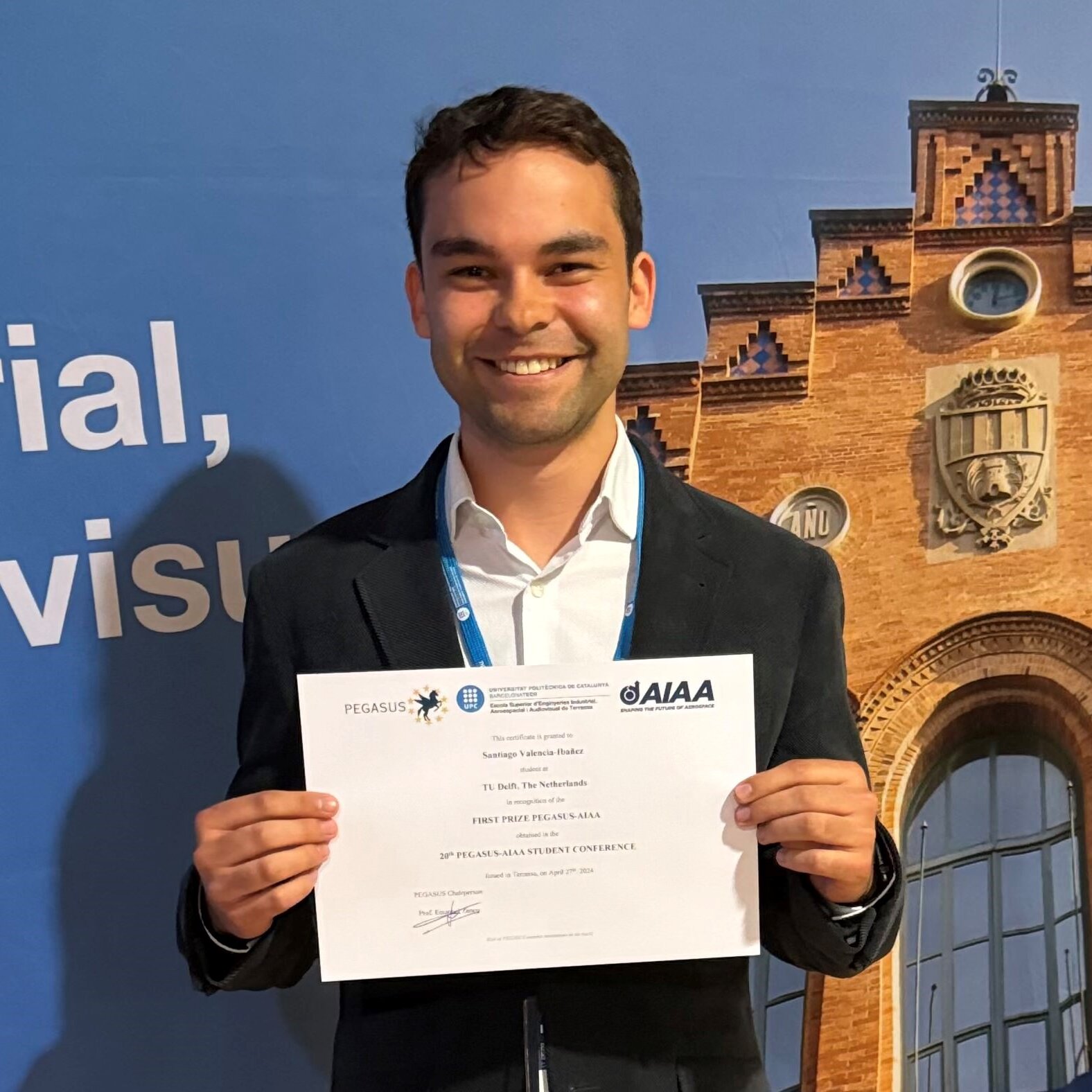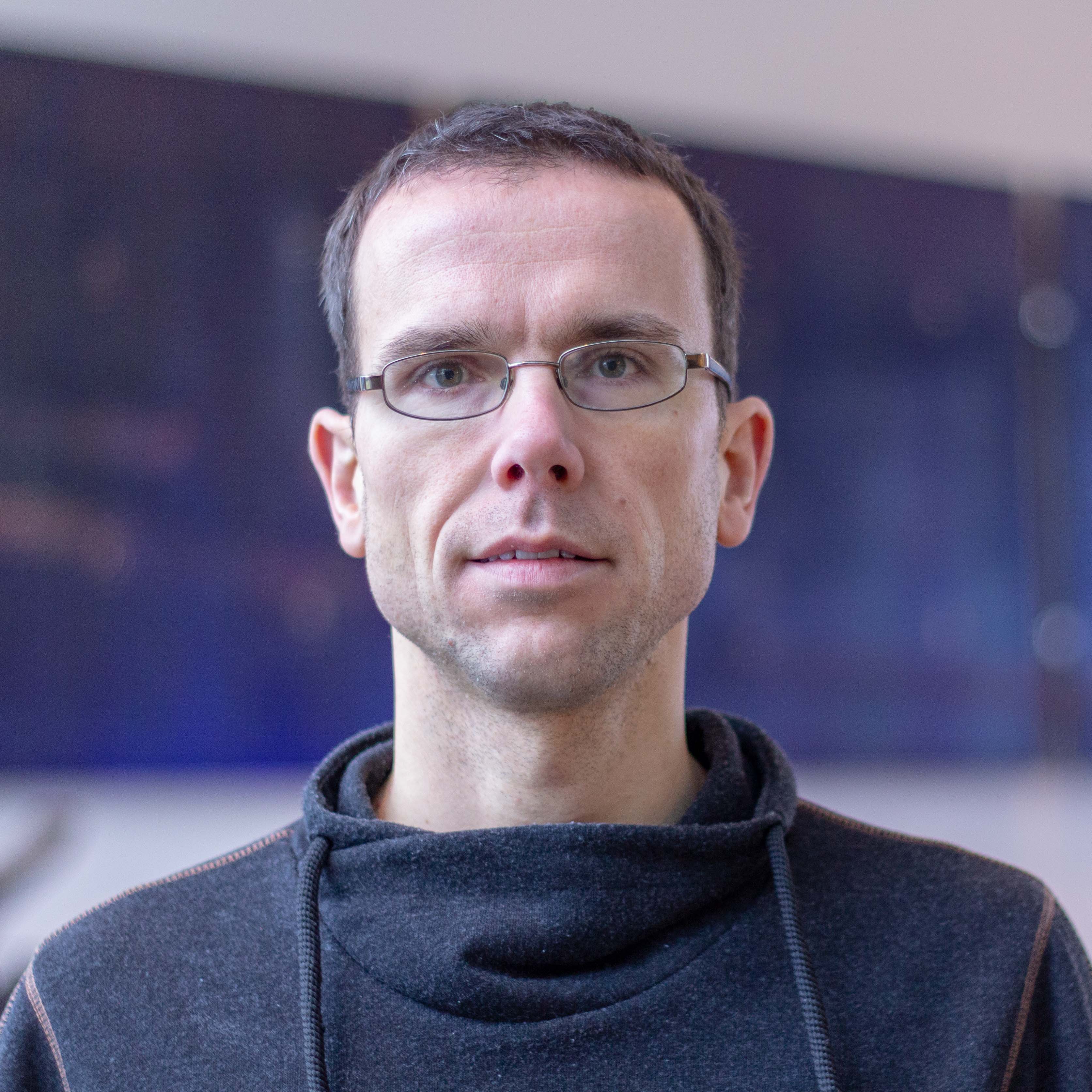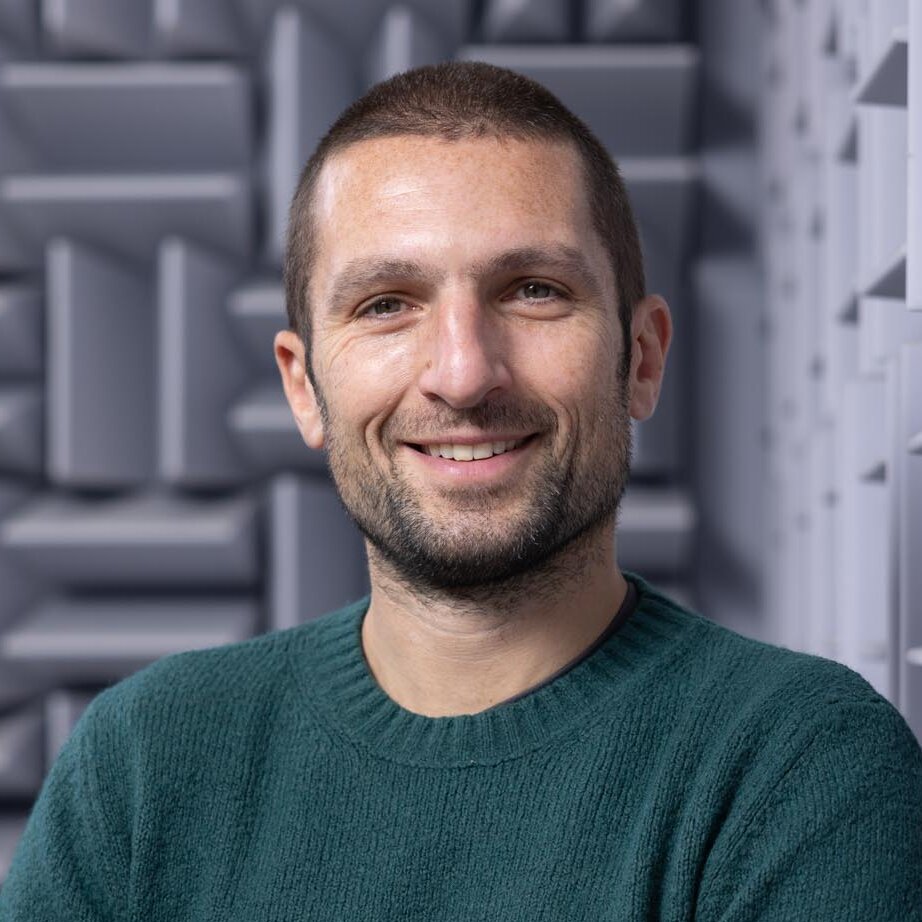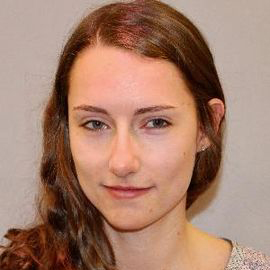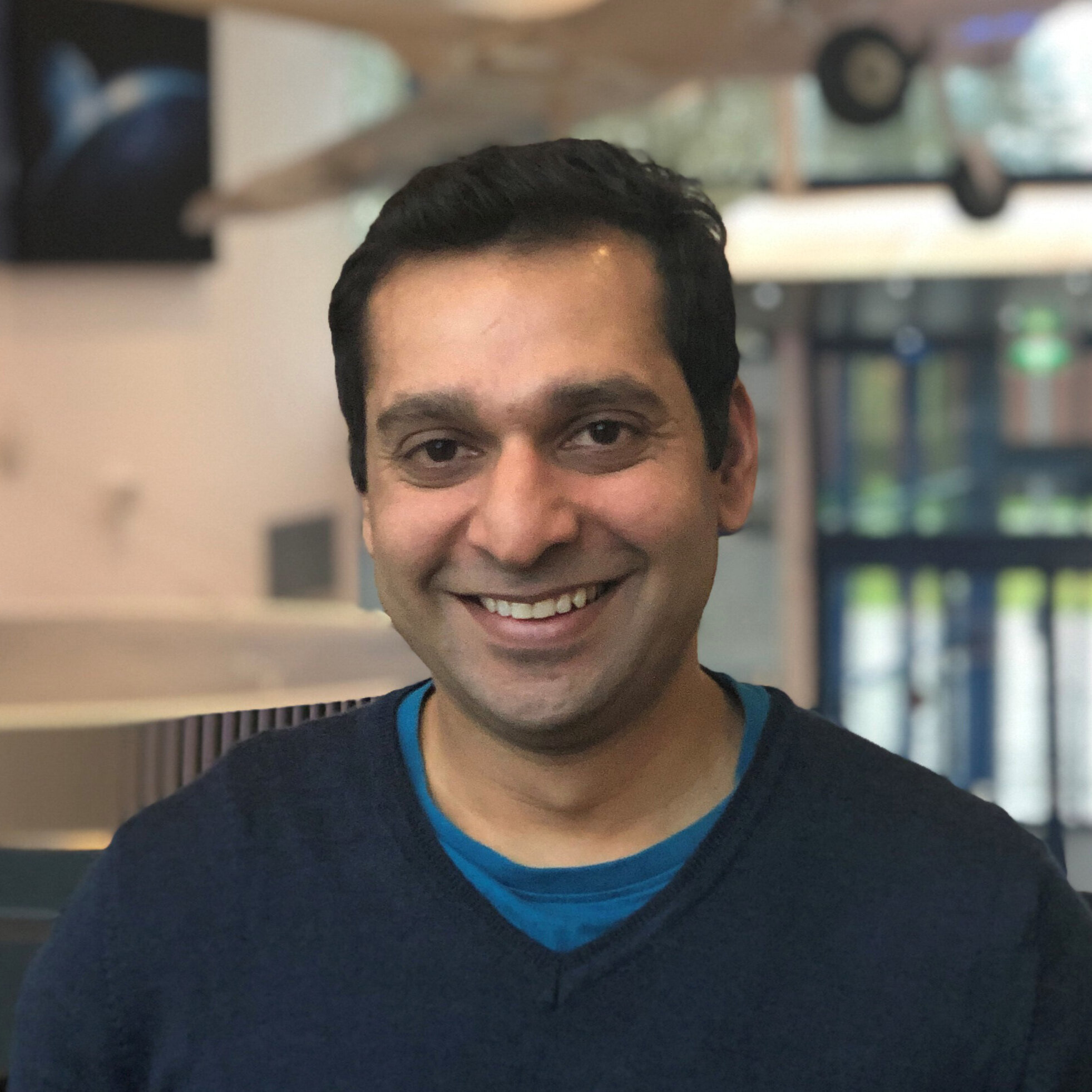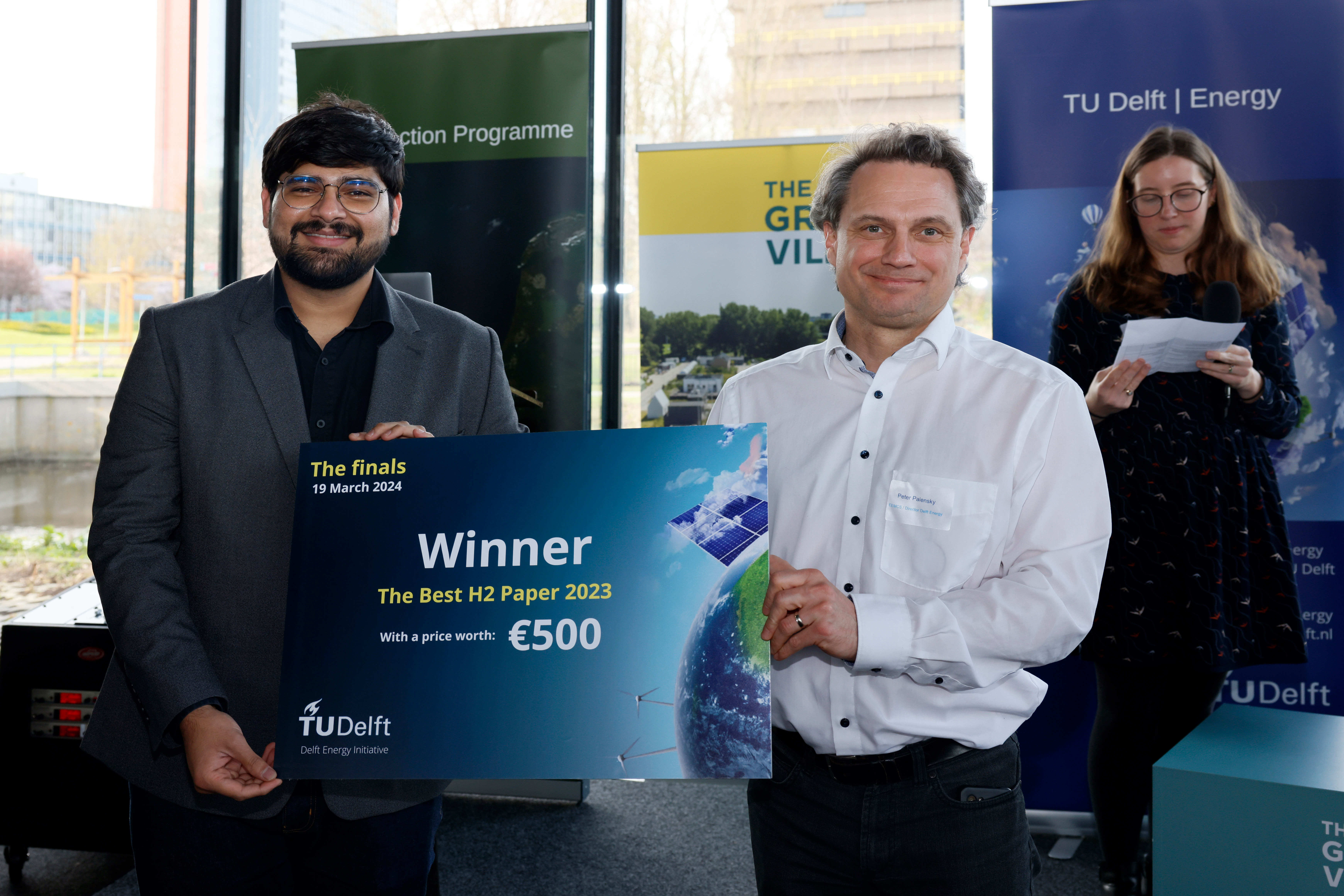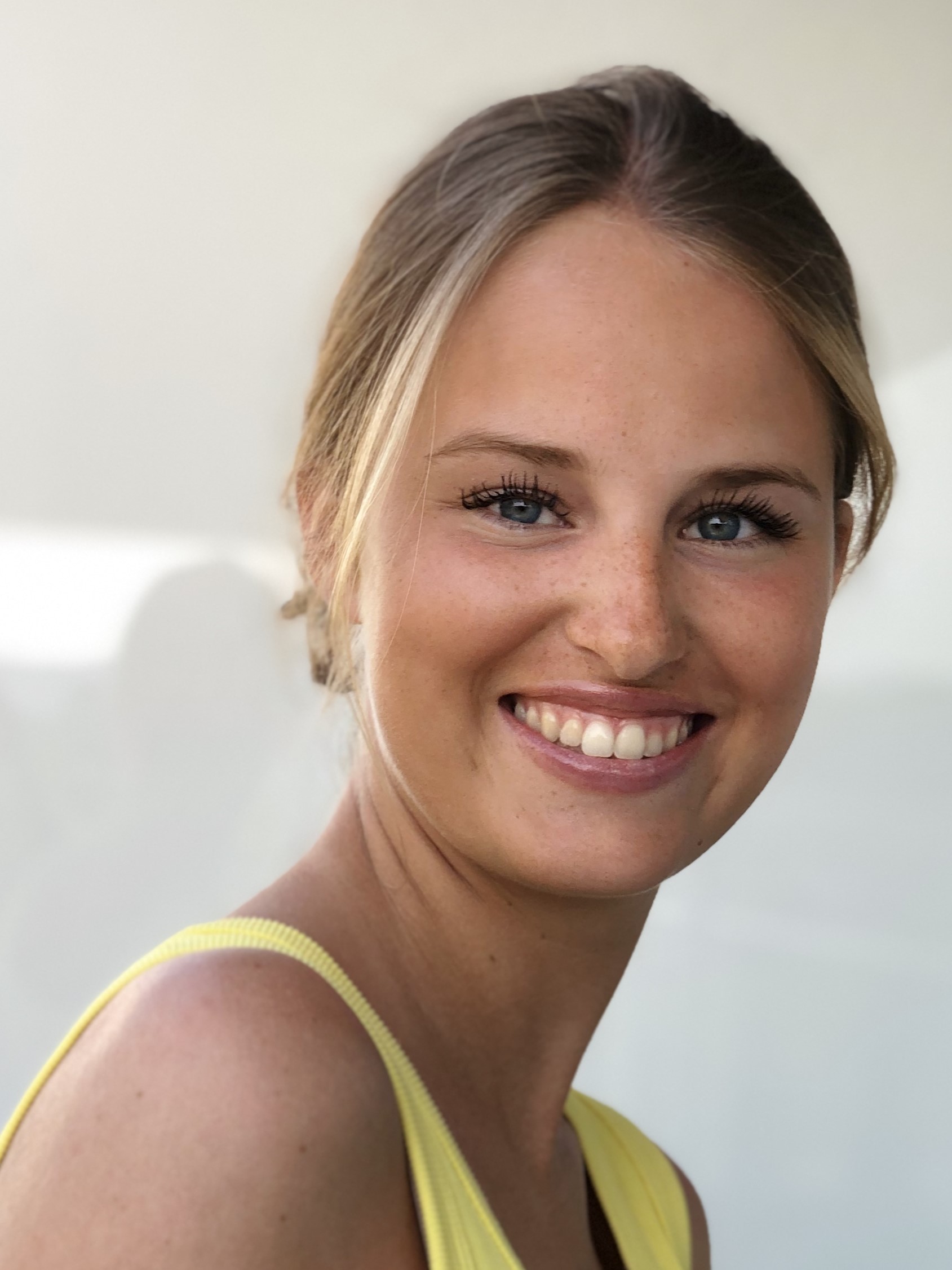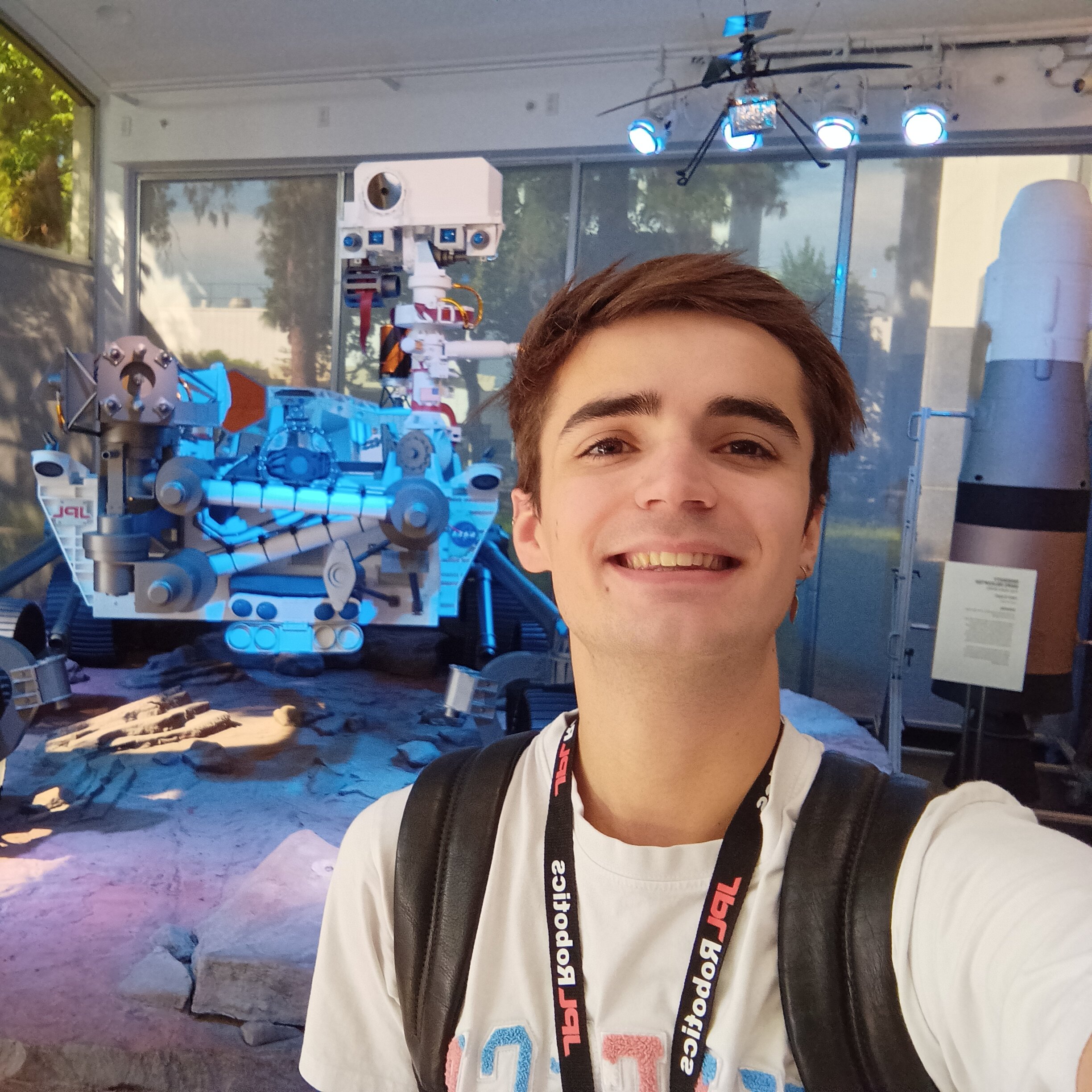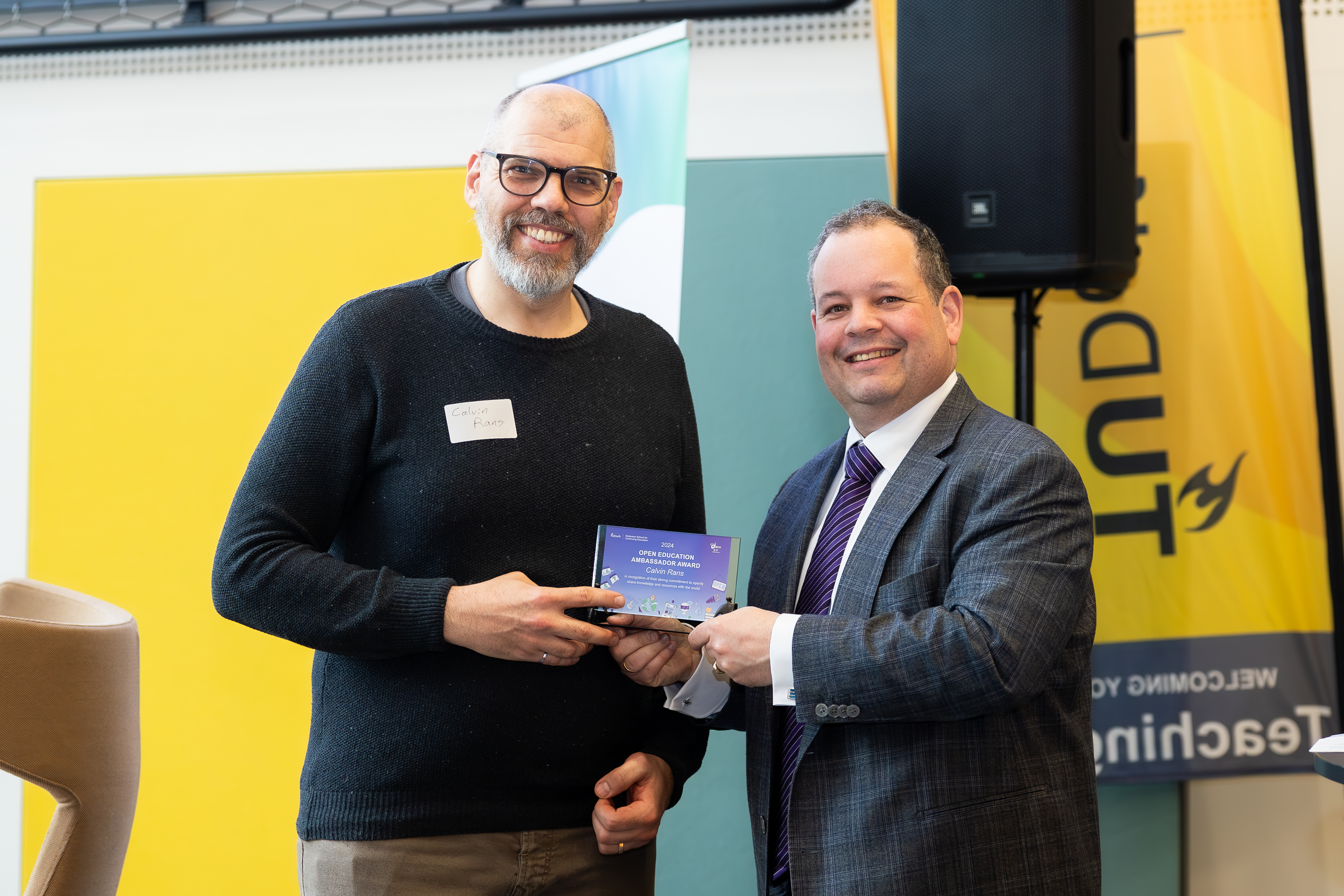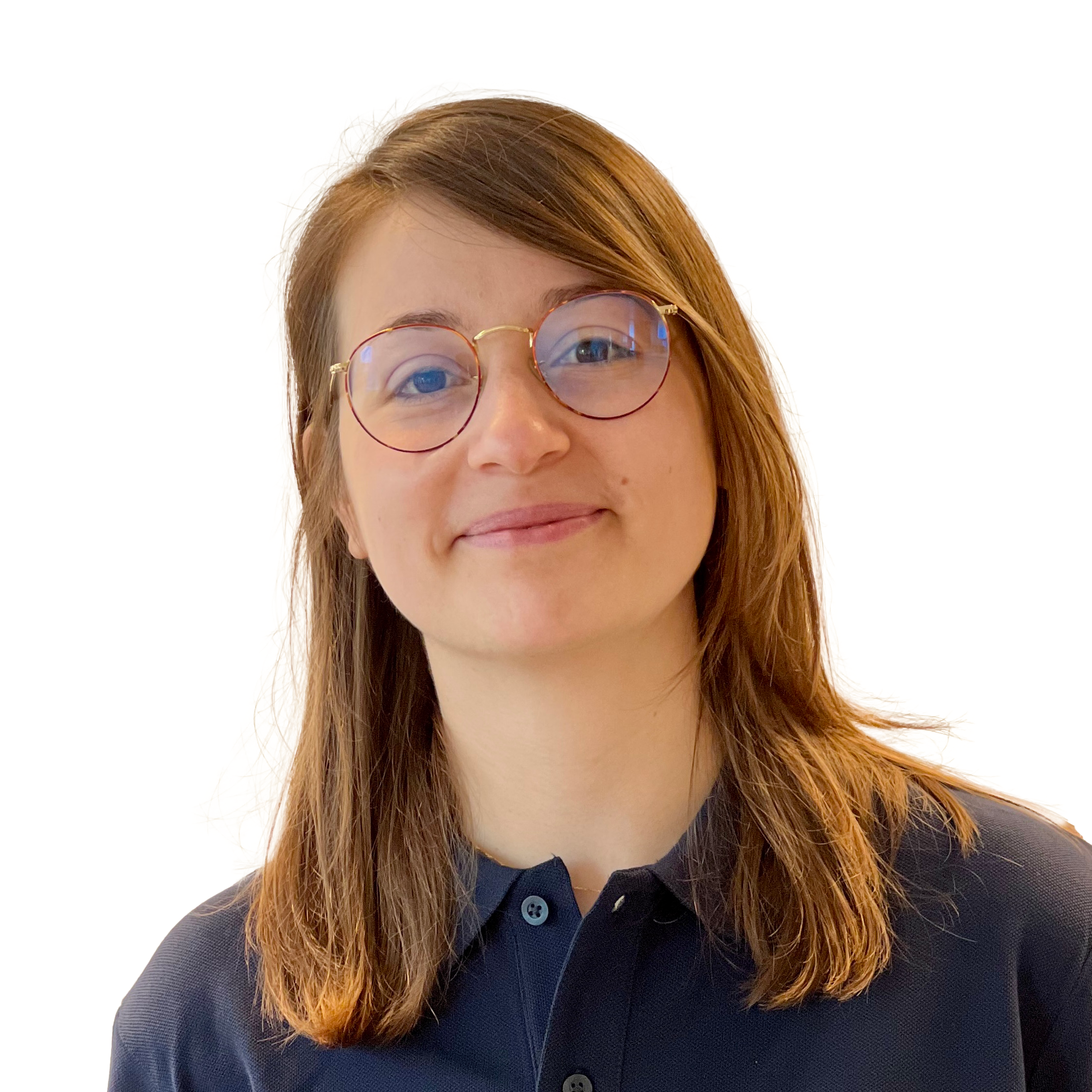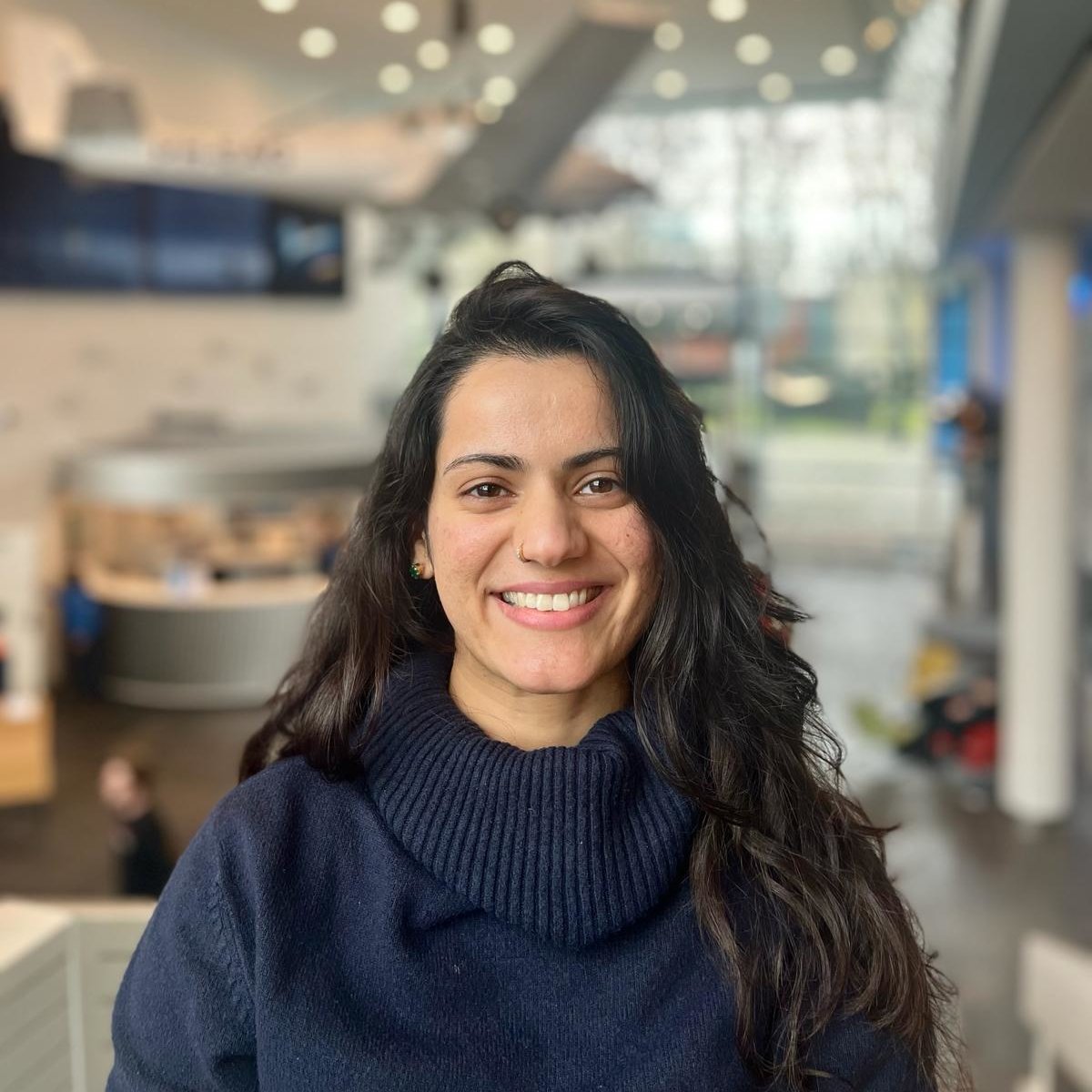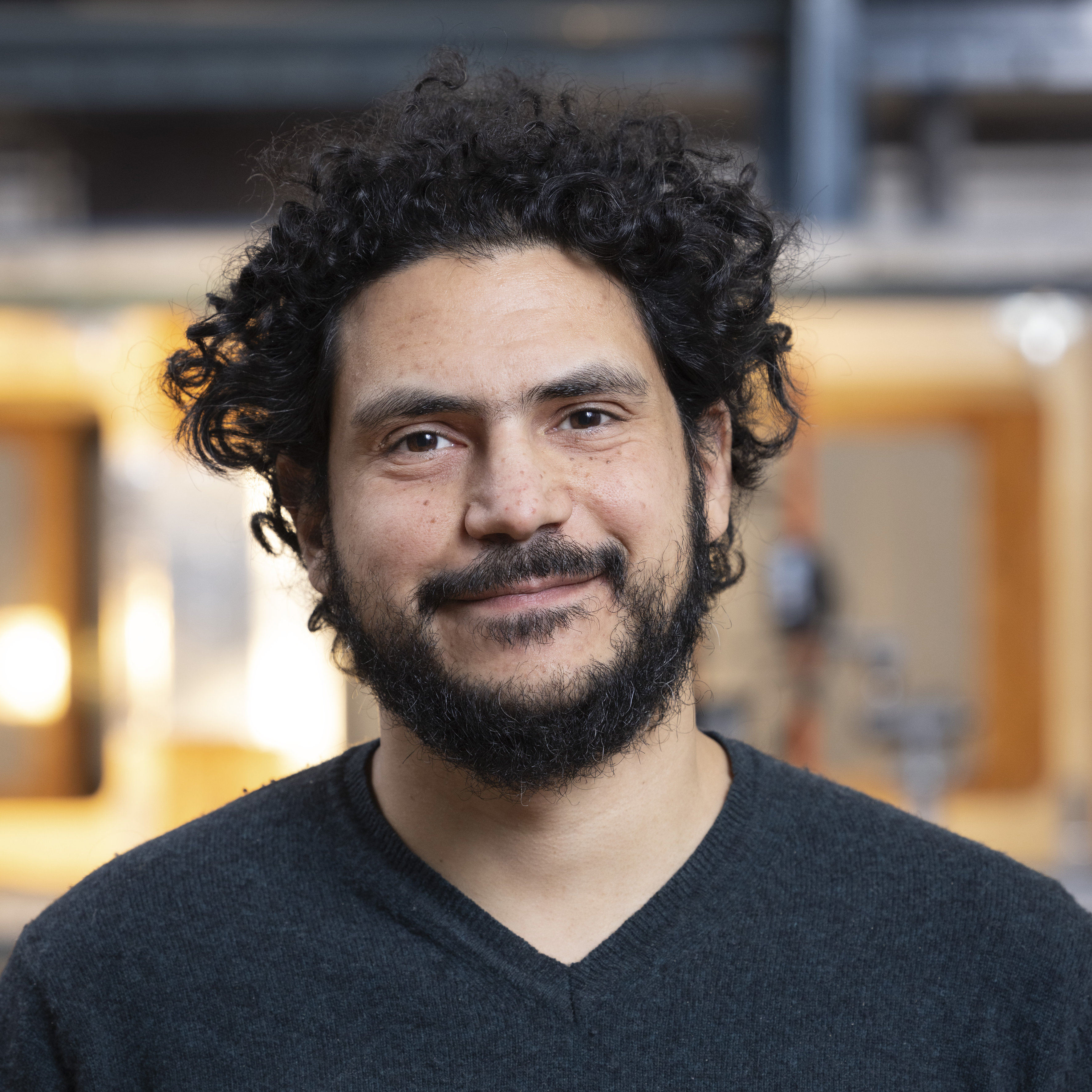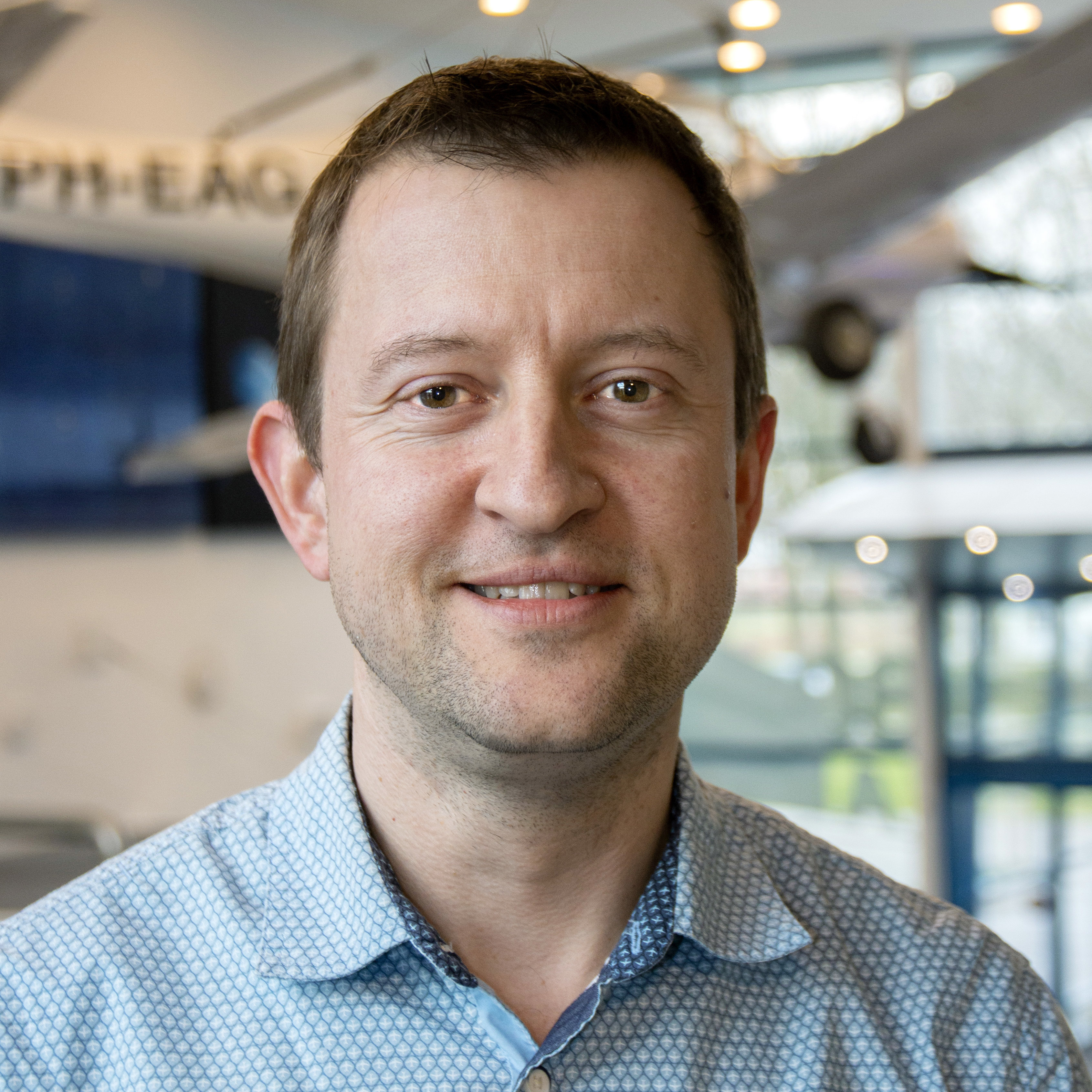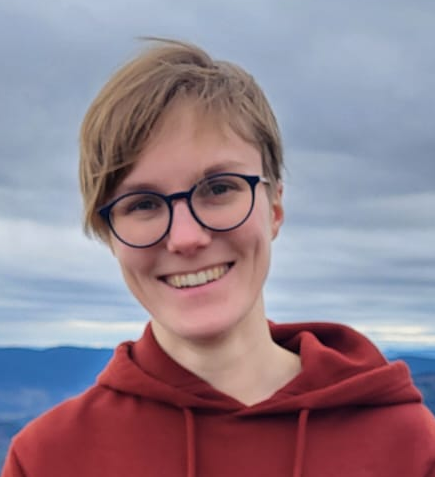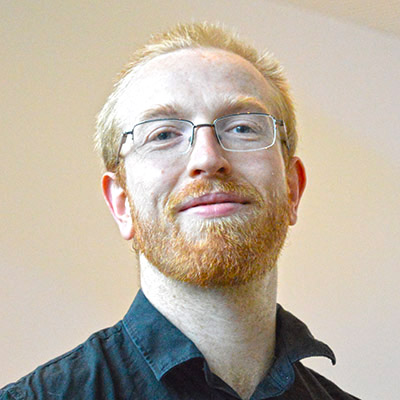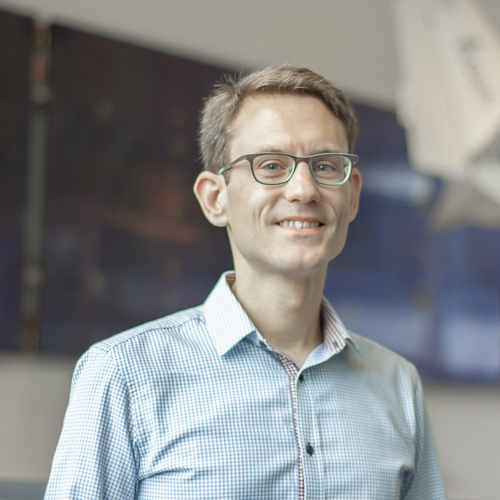At the faculty of Aerospace Engineering, we all work hard on world-class teaching and research. This leads to great achievements that sometimes result in a grant or award. These successes are an inspiration and contribute to a sense of pride and belonging to our faculty, which we are pleased to share on this page.
Collaboration with Embraer wins von Kármán Award for International Cooperation in Aeronautics
12-09-2024 | Roeland De Breuker, Saullo Castro, Mohamed Elafly and Hauke Maathuis
At the ICAS conference in Florence, the internationally renowned award was awarded to the Aeroelastic Tailoring Project led by Embraer. The group of Roeland De Breuker at Aerospace Structures and Materials is partner in this project that comes up with new technology and innovations for lightweight composite aircraft wings.
ERC Starting Grant for predicting and controlling extreme events in flows
05-09-2024 | Anh Khoa Doan
Anh Khoa Doan has received an ERC Starting Grant for his research on predicting and controlling extreme events in turbulent flows, such as the atmosphere or the oceans, with scientific machine learning. Predicting and controlling these events can help in making renewable technology more resilient and in creating a climate resilient society. This European grant of €1.5 million for a five-year research programme is intended to enable individual scientists to build their own teams and conduct groundbreaking research.
Dr Potin has received a Veni grant from NWO. Potin is researching the use of light polarisation to detect, isolate and better identify carbon-based molecules, the possible building blocks of life, on the surfaces of asteroids and comets in Space. The €320.000 Veni grant will enable her to further develop her research into the so far unexplored use of ‘spectro-polarimetry’ for this purpose.
NWO OTP funding for quality assurance in metal additive manufacturing
11-07-2024 | Kunal Masai and Vahid Yaghoubi Nasrabadi
Kunal Masai and Vahid Yaghoubi Nasrabadi, together with researchers from the University of Groningen, have been awarded funding from NWO under the Open Technology Programme. The funding has been awarded for their research to develop a new advanced methodology for quality assurance in metal additive manufacturing.
Additive Manufacturing (AM) or 3D printing technology (3DP) is fundamentally transforming manufacturing processes in various industries. However, the risks associated with less than ideal printing conditions pose challenges for ensuring the safe quality of AM parts and affect their strength and consistency. This project aims to address these issues by developing an advanced vibrational Non-Destructive Testing (NDT) methodology for quality assurance in metal AM. We aim to optimise the benefits of AM, especially for complex geometries, and gain insights that improve AM variability for safer application of metal AM technology.
IEEE AP-S Graduate Fellowship for Research in RF Front-End Design and Antenna Technologies for Space Applications
09-09-2024 | Pallab Gogoi
Pallab Gogoi has been awarded the IEEE AP-S Graduate Fellowship for his research in antenna technologies for space applications. He works under the supervision of Dr. Jérôme Loicq and Dr. Jurgen Vanhamel in the department of Space Engineering. Pallab works on RF (radiofrequency) front-ends which are crucial for driving Spectroscopic devices—used to analyze how light interacts with materials to identify and quantify their components— and require highly efficient and miniaturized RF back-ends for tasks such as space weather monitoring, environmental sensing (including the detection of greenhouse gases), and identifying new elements in space exploration.
In addition to this, Pallab is also advancing the development of small deployable antennas that enhance communication links for scientific applications such as radio astronomy. His innovative work is particularly relevant to the advancement of smaller satellite systems like PocketQubes. These technologies are essential for promoting sustainable space technology and environmental monitoring, and align with the United Nations Sustainable Development Goals.
This fellowship not only acknowledges Pallab’s significant research contributions but also supports his ongoing efforts to overcome the challenges of creating compact, efficient antennas for miniaturized satellites, which are key to enhancing communication links for scientific applications such as radio astronomy and space weather monitoring systems.
Planetary scientists have long believed that the organic macromolecules that make the Earth suitable for life come from chondrites. But until now, the question has been how these acquired the macromolecules. An international team of researchers has found an explanation for this using observation-based computer models. They have published their findings in Nature Astronomy.
Science Robotics-publicatie: Ant-inspired robot navigation
17-07-2024 | Tom van Dijk, Christophe de Wagter en Guido de Croon
Researchers felt inspired by biological findings on how ants visually recognize their environment and combine it with counting their steps in order to get safely back home. They have used these insights to create an insect-inspired autonomous navigation strategy for tiny, lightweight robots and have published their findings in Science Robotics.
How to determine the optimal sequence of angles at which the material’s layers are composed and stacked when design of fibre-reinforced composite materials? The QAIMS team have now gone through to the final rounds of the Airbus-BMW Quantum Computing Challenge where they will pitch their quantum computing approach to ‘push the boundaries of quantum tech for mobility.’
When water levels on Earth rise or fall, we need to know quickly to ensure no one is in danger. To do this, it's essential to understand the global water system and measure water levels frequently at high accuracy, high resolution and in many places. Dr. Jian Guo and his team at TU Delft, in collaboration with industrial partners COMET Ingeniería and ISISPACE, have developed a new concept called Alticube+. This proposal was recently selected by ESA from over seventy proposals for further development with a team of ESA experts.
Guido de Croon, together with Federico Paredes-Vallés, Jesse Hagenaars, Julien Dupeyroux, Stein Stroobants and Yingfu Xu has developed a drone that flies autonomously using neuromorphic image processing and control based on the workings of animal brains. Animal brains use less data and energy compared to current deep neural networks running on GPUs (graphic chips). Neuromorphic processors are therefore very suitable for small drones because they don’t need heavy and large hardware and batteries. The results are extraordinary: during flight the drone’s deep neural network processes data up to 64 times faster and consumes three times less energy than when running on a GPU. Further developments of this technology may enable the leap for drones to become as small, agile, and smart as flying insects or birds. The findings were recently published in Science Robotics.
When water levels on Earth rise or fall, we need to know quickly to ensure no one is in danger. To do this, it's essential to understand the global water system and measure water levels frequently at high accuracy, high resolution and in many places. Dr. Jian Guo and his team at TU Delft, in collaboration with industrial partners COMET Ingeniería and ISISPACE, have developed a new concept called Alticube+. This proposal was recently selected by ESA from over seventy proposals for further development with a team of ESA experts.
NWO OTP funding for quality assurance in metal additive manufacturing
11-07-2024 | Vahid Yaghoubi and Kunal Masania
Vahid Yaghoubi and Kunal Masania, together with researchers from the University of Groningen, have been awarded funding from NWO under the Open Technology Programme. The funding has been awarded for their research to develop a new advanced methodology for quality assurance in metal additive manufacturing.
Additive Manufacturing (AM) or 3D printing technology (3DP) is fundamentally transforming manufacturing processes in various industries. However, the risks associated with less than ideal printing conditions pose challenges for ensuring the safe quality of AM parts and affect their strength and consistency. This project aims to address these issues by developing an advanced vibrational Non-Destructive Testing (NDT) methodology for quality assurance in metal AM. This innovative approach will integrate data-driven modeling, model frequency analysis, and Transparent AI to ensure quality assurance in metal additive manufacturing (AM). We aim to optimise the benefits of AM, especially for complex geometries, and gain insights that improve AM variability for safer application of metal AM technology.
Santiago Valencia Ibáñez has been awarded first place at the 20th Pegasus-Europe AIAA student conference 2024 for his Master’s thesis on system architecture optimization in aerospace engineering. His work aims to prevent the premature dismissal of product architectures that could lead to the best-performing designs, crucial for next-generation, sustainable aircraft. The results of Valencia Ibáñez's thesis make it easier to identify the most promising and feasible designs.
Guido de Croon, together with Federico Paredes-Vallés, Jesse Hagenaars, Julien Dupeyroux, Stein Stroobants and Yingfu Xu has developed a drone that flies autonomously using neuromorphic image processing and control based on the workings of animal brains. Animal brains use less data and energy compared to current deep neural networks running on GPUs (graphic chips). Neuromorphic processors are therefore very suitable for small drones because they don’t need heavy and large hardware and batteries. The results are extraordinary: during flight the drone’s deep neural network processes data up to 64 times faster and consumes three times less energy than when running on a GPU. Further developments of this technology may enable the leap for drones to become as small, agile, and smart as flying insects or birds. The findings were recently published in Science Robotics.
Comenius grant to develop planetary rock collection supports educational innovation
05-06-2024 | Sebastiaan de Vet
Sebastiaan de Vet has received a Comenius grant for his proposal to start developing a ‘Planetary Analogue Rock Collection’ (PARC) for use in education. By allowing students to work with terrestrial rocks and minerals that also occur on other planetary bodies, as well as with their ‘digital twins’ (interactive 3D models), De Vet aims to make the learning process more compatible with current insights from research into the interior properties and surface materials of the rocky planets in the solar system. After all, some basic knowledge of geological materials is necessary for designing space missions and their instrumentation, but also for conducting planetary research using those missions and instruments. Together with Bart Root, Sophie Guerrero-Harpe and Mahsa Sajedi, De Vet will explore the best approach and added value of ‘the materials perspective’ in several courses.
The Comenius grant was awarded from the Comenius Teaching Fellows 2024 programme by the National Educational Research Organisation (NRO). Meanwhile, the new round for the 2025 programme has been opened for applications by interested lecturers. NRO's Comenius programme began in 2017 and focuses on educational renewal and innovation and gives education professionals the opportunity to further develop their careers.
Read more about applying for a Comenius 2025 Grant here.
Wouter van der Wal, together with AE alumni Bob van Noort and Alfonso Mateo Aguarón, and Sander Goossens and Erwan Mazarico at NASA, has published in Nature Astronomy new evidence for an underground ocean on Saturn's moon Titan.
Analysis of speed measurements taken by the Cassini satellite as it flew past Saturn's moon Titan suggests that Titan has an underground ocean of water and ammonia. The analysis also suggests that the layer of ice between the ocean and the moon's rocky core may be thinner than previously thought, making the exchange of material between rock and ocean more plausible. This could indicate the presence of the building blocks of life.
Daniele Ragni was awarded an ERC Consolidator Grant from the European Research Council for his research project MORASINA (Modelling Rotor Aircraft Surface Interaction Noise for Acoustic Prediction). With this, Ragni will research noise caused by the interaction of rotors with airframe components in order to more accurately predict and ultimately reduce noise.
Dr. Yoshinari Hashimoto, visiting scientist in the department Control & Operations (section Control & Simulation) has been awarded the 70th Okochi Memorial Technology Prize by the Okochi Memorial Foundation in Japan for his achievement in the development of an automatic control system for blast furnace operations. The Okochi Memorial Technology Prize is awarded for outstanding original research achievements in industrial engineering in Japan. The award ceremony was held in Tokyo on March 26.
Highly efficient and stable operation of blast furnaces in the steel industry is crucial to reduce CO2 emissions. Hashimoto et al. developed an automatic control system based on a mathematical model that calculates the internal state of the furnaces in real time and published two journal papers with Prof. Mulder and Prof. Van Paassen (C&S). This automated system has been put to practical use in actual blast furnace operations, contributing to the reduction of CO2 emissions and workload of operators. During his two year stay at TU Delft, Dr. Hashimoto explores the use of ecological interface design to retain the skills of proficient operators in future automated and sustainable blast furnace operation.
Advanced Materials publication: Mimicking biological matter with 3D printing
19-03-2024 | Caroline Houriet and Kunal Masania
Caroline Houriet and Kunal Masania have found an approach to replicate the complex microstructures found in nature using 3D printing techniques. This opens up new possibilities for designing and fabricating lightweight parts with high mechanical performance while also being recyclable. The team presented their new insights in Advanced Materials.
With his paper "Thermodynamic analysis of a zero-emission combustion cycle for energy transition", Kausal Dave won first place for the TU Delft H2 Platform. Moreover, this paper, together with 8 others, was selected for the best TU Delft Climate publication and the best TU Delft Energy publication.
For his research, Kaushal Dave analysed and optimised the innovative HYCOS combustion cycle and arrived at an impressive, theoretically achievable gas-to-electricity efficiency of over 55%. His research offers it good hope for achieving a carbon-free global economy.
Roberto Merino Martinez, together with two researchers from the Faculty of IDE, has been awarded funding from NWO under the Open Technology Programme for their research on the acoustic environment in pediatric ICUs.
The acoustic environment has a major impact on human health. Imagine what hospital sounds mean for the stress levels of children in ICUs, for example. The funding will allow scientists to develop new algorithms that identify sound-producing events and assess its quality. The information will be represented on a digital platform to increase nurses’ understanding of the ‘auditory footprint’ of different sounds and empower them to act to improve it.
Elise Scheers has received the Hans Wittenberg Prize 2024 for her thesis titled: "Coupled Hybrid Electric Aircraft Design and Strategic Airline Planning". Her research focuses on integrating hybrid-electric aircraft design with strategic airline planning, aiming to develop a methodology for optimizing a hybrid-electric aircraft fleet's design while considering its impact on airline operations and network emissions. She was supervised by Dr. Maurice Hoogreef.
Juan Garcia Bonilla has received the Heinz Stoewer Space award 2024 for his thesis, titled "Uncertainty Quantification for Solar Sails in the Near-Earth Environment." Bonilla’s work aims to identify and quantify the effects of the key sources of uncertainty in Solar Sails missions around the Earth. This allows mission designers to design robust systems capable of success amidst uncertainty. He was supervised by Dr. Jeannette Heiligers.
Each year, on the occasion of global Open Education Week, TU Delft celebrates nine lecturers for their commitment to openly share knowledge and educational resources with the world.
Nominated by their faculties and QuTech, they receive the award from the Executive Director of the TU Delft Extension School for Continuing Education in an open ceremony at the Teaching Academy.
Calvin Rans received this award for contributing to openness and sharing in teaching & learning practices and materials beyond the TU Delft campus, with accolades from students and peers at other universities and worldwide. In addition to being the responsible lecturer for the openly licenced MOOC Introduction to Aerospace Structures and Materials, for seeking to introduce new open formats and tools to better cater to different learner audiences – more recently for example using a ChatGPT-generated video or creating an engaging ‘mission to space’ campus course to bring situations to life through digital tools. Finally, for regularly sharing experiences and lessons learned in engineering education, including as Chair of the Open and Online Education interest group.
More information:
Open Education Ambassadors
Open Education Ambassador Awards for TU Delft lecturers
TU Open Education funding for proposal on inclusive STEM education
05-03-2024 | Anandini Jayanthi and Isabelle El-Hajj
Anandini Jayanthi and Isabelle El-Hajj, who are part of the aerospace D&I education working group, participated in a proposal to the Open Education Stimulation Fund led by the faculty EEMCS. With the proposal, they aim to strengthen diversity and inclusion in our education. The proposal entitled “Towards Open Inclusive STEM Education” has been granted.
A short summary of the project goals: "With our project, we want to support and educate teachers on the meaning of inclusive education. And provide them with the tools to implement this knowledge, and collect open education resources and examples that they can reuse in their own education. Although initially motivated by a lack of women in STEM, we aim to include other minorities and diversity aspects where possible. With this project, we want to make the barrier to creating and using inclusive education as low as possible and show that, even with small adjustments, you can work towards more inclusive education.” We hope this will help strengthen D&I in our education.
More information: Open Education Stimulation Fund 2023 (tudelft.nl)
Prof. Marios Kotsonis was awarded a €1.5 million Vici grant from NWO (Dutch Research Council) for his research ‘Running up that hill’ into reducing the aerodynamic drag of aircraft through controlling the airflow over the wings. This novel finding can revolutionise laminar wings, potentially saving millions of tons of fuel and harmful emissions every year.
Read more
Prof. Guido De Croon was awarded a €1.5 million Vici grant from NWO (Dutch Research Council) for his research of insect-inspired, neuromorphic AI for autonomous robots.
AI requires heavy computing devices that make robots heavy and dangerous, and therefore unsuitable for many applications. In this project, the AI will be modelled after insect intelligence and instilled on a resource-restricted drone, unlocking innumerable new applications.
Coen de Visser was awarded a €2 million ERC Consolidator Grant from the European Research Council for his research project ARCS (Autonomous Robots with Common Sense).
In the ARCS project, he will develop a new principle in control engineering: Artificial Physical Awareness (APA). With APA, autonomous robots such as drones and self-driving cars become aware of their own physical capabilities and limitations. This ultimately will help them operate safely in close proximity to humans, animals, and infrastructure.
Prof. Marios Kotsonis was awarded a €2.4 million ERC Consolidator Grant from the European Research Council (ERC) for his research project MetaWing.
Kotsonis' research aims to pave the way for ultra-low drag aircraft wings for use in emission-free aviation. To achieve this goal, he and his team are developing a new class of metamaterials: engineered composite structures that create extraordinary wave phenomena, which they intend to utilize for flow control.
Read more
Marie Fayolle and Dominic Dirkx have been awarded funding from NWO within the programme 'Use of space infrastructure for Earth Observation and Planetary Research’ (GO) for their research proposal ‘Elucidating tidal dissipation through open science - a window on the evolution of Titan and the Saturnian system from radio science and astrometry’. With this research, they aim to provide enriched insight into the evolution of the Saturnian system and its moon Titan in particular, thus shedding new light onto the processes that drive icy satellite evolution in general.
Many moons of Jupiter and Saturn have a deep global ocean of liquid water under an icy surface. This makes these icy moons very interesting from an astrobiological perspective, since liquid water is a key ingredient for life as we know it. The researchers will use data from the Cassini mission to re-analyze the orbital evolution of the large Saturnian moons, with a focus on the moon Titan. Past analyses of this type have led to conflicting results, calling into question evolution scenarios of these moons' interiors.
The majority of the analyses will be done using open-source tools, based on the Tudat astrodynamics software. Publications will be accompanied by software repositories, allowing anyone in the community to scrutinize the work in detail, and attempt to extend or improve the analysis without having to reinvent the wheel.
Christian Siemes has been awarded funding from NWO within the programme 'Use of space infrastructure for Earth Observation and Planetary Research’ (GO) for his research proposal RAM. RAM, which stands for ‘relative accelerator modelling’ aims to make a crucial contribution to the success of the GRACE-FO mission by improving the accuracy of the data received from the underperforming accelerometer on the second GRACE-FO satellite.
The GRACE-FO mission measures how Earth’s gravity field changes over time, which gives invaluable data on how fast the ice sheets melt, how much ocean mass changes contribute to sea level rise, the level of groundwater depletion and recharging, and many other geophysical processes. Unfortunately, the accelerometer on the second GRACE-FO satellite performs worse than expected, which poses a severe limitation for the mission. The emergency solution is to transform the data from the well-performing accelerometer on the first satellite to represent the forces acting on the nearby second satellite, a process called ‘transplanting’ the accelerometer data. Such transplantation requires accurate modelling of aerodynamic forces and radiation pressure, for which we will employ state-of-the-art methods developed for atmospheric research. The modelling is based on a photorealistic model of the satellite, ray-tracing algorithms developed for computer graphics, and a fine-tuning of the description of satellite surface properties based on sophisticated analysis of in-flight data.

